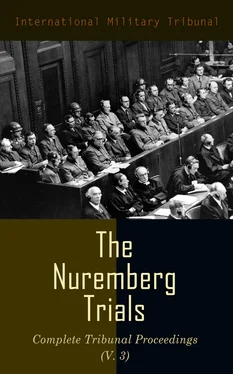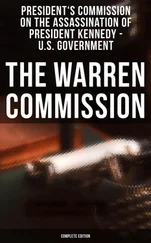DR. STAHMER: Mr. President, the Defense objects to the use of this document. This document was drawn up as late as 22 November 1945, here in Nuremberg, and the witness Berger could, therefore, be brought to Court without any difficulty. We must insist that he be heard here on the subjects on which the Prosecution wishes to introduce his testimony. That would be the only way in which the Defense could have an opportunity of cross-examining the witness and thereby contribute to obtaining objective truth.
[Pause in the proceedings while the Tribunal consulted.]
THE PRESIDENT: The Tribunal upholds the objection and will not hear this affidavit. It is open to either the Prosecution or the defendants, of course, to call the man who made the affidavit. That is all I have to say. We have upheld your objection.
MR. ALDERMAN: If the Tribunal please, I had another affidavit by one Alfred Helmut Naujocks which, I take it, will be excluded under this same ruling, and which, therefore, I shall not offer.
THE PRESIDENT: If the circumstances are the same.
MR. ALDERMAN: Yes, I might merely refer to it for identification because it is in your document books.
THE PRESIDENT: Very well.
MR. ALDERMAN: It is Document 3029-PS.
THE PRESIDENT: Very well. That also will be rejected as evidence.
MR. ALDERMAN: Yes. Offensive operations along the Czechoslovakian border were not confined to skirmishes carried out by the Free Corps. Two SS-Totenkopf (Deathhead) battalions were operating across the border in Czech territory near Asch.
I quote now from Item 36 in the Schmundt file, an OKW most-secret order, signed by Jodl, and dated 28 September. This appears at Page 61 Of the Schmundt file:
“Supreme Command of the Armed Forces, Berlin, 28 September 1938; 45 copies, 16th copy; most secret.
“Subject: Four SS-Totenkopf battalions subordinate to the Commander-in-Chief Army.
“To: Reichsführer SS and Chief of the German Police (SS Central Office) (36th copy).
“By order of the Supreme Command of the Armed Forces the following battalions of the SS Deathhead organization will be under the command of the Commander-in-Chief of the Army with immediate effect.
“Second and Third Battalions of the 2d SS-Totenkopf Regiment Brandenburg at present in Brieg (Upper Silesia).
“First and Second Battalions of the 3d SS-Totenkopf Regiment Thuringia, at present in Radebeul and Kötzschenbroda near Dresden.
“Commander-in-Chief of the Army is requested to deploy these battalions for the West, (Upper Rhine) according to the Führer’s instructions.
“These SS-Totenkopf units now operating in the Asch promontory (I and II Battalions of the SS-Totenkopf Regiment Oberbayern) will come under the Commander-in-Chief of the Army only when they return to German Reich territory, or when the Army crosses the German-Czech frontier.
“It is requested that all further arrangements be made between Commander-in-Chief of the Army and Reichsführer SS (SS Central Office).
“For the Chief of the Supreme Command of the Armed Forces, Jodl.”
According to the 25 September entry in General Jodl’s diary, these SS-Totenkopf battalions were operating in this area on direct orders from Hitler. As the time X-Day approached, the disposition of the Free Corps became a matter of dispute.
On 26 September Himmler issued an order to the Chief of Staff of the Sudeten German Free Corps, directing that the Free Corps come under control of the Reichsführer SS in the event of German invasion of Czechoslovakia. This document is Item 37 in the Schmundt file, on Page 62.
On 28 September Defendant Keitel directed that as soon as the German Army crosses the Czech border, the Free Corps will take orders from the OKH. In this most-secret order of the OKW, Keitel discloses that Henlein’s men are already operating in Czechoslovak territory.
I read now from Item 34 of the Schmundt file on Page 58, the last three paragraphs of this most-secret order:
“For the Henlein Free Corps and units subordinate to it the principle remains valid, that they receive instructions direct from the Führer and that they carry out their operations only in conjunction with the competent corps headquarters. The advance units of the Free Corps will have to report to the local commander of the frontier guard immediately before crossing the frontier.
“Those units remaining forward of the frontier should, in their own interests, get into communication with the frontier guard as often as possible.
“As soon as the Army crosses the Czechoslovak border the Henlein Free Corps will be subordinate to the OKH. Thus it will be expedient to assign a sector to the Free Corps, even now, which can be fitted into the scheme of army boundaries later.”
On 30 September, when it became clear that the Munich Settlement would result in a peaceful occupation of the Sudetenland, the Defendant Keitel ordered that the Free Corps Henlein, in its present composition, be placed under the command of Himmler.
I read from Item 38, at Page 63, of the Schmundt file:
“1. Attachment of the Henlein Free Corps. The Supreme Commander of the Armed Forces has just ordered that the Henlein Free Corps in its present composition be placed under command of Reichsführer SS and the Chief of German Police. It is therefore not at the immediate disposal of OKH as field unit for the invasion, but is to be later drawn in, like the rest of the police forces, for police duties in agreement with the Reichsführer SS.”
I have been able, if the Tribunal please, to ascertain the dates the Tribunal asked about before the recess.
The first visit of Chamberlain to Germany in connection with this matter was 15 September 1938. Chamberlain flew to Munich and arrived at 12:30 o’clock on 15 September. He went by train from Munich to Berchtesgaden, arriving at 1600 hours, by car to Berghof, arriving about at 1650, for three talks with Hitler. On 16 September Chamberlain returned by air to London.
The second visit was on 22 September. Chamberlain met with Hitler at Bad Godesberg at 1700 hours for a 3-hour discussion, and it was a deadlock. On 23 September discussions were resumed at 2230 hours. On 24 September Chamberlain returned to London.
The third visit was on 29 September. Chamberlain flew to Munich and the meeting of Chamberlain, Mussolini, Daladier, and Hitler took place at the Brown House at 1330 and continued until 0230 hours on 30 September 1938, a Friday, when the Munich Agreement was signed. Under the threat of war by the Nazi conspirators, and with war in fact about to be launched, the United Kingdom and France concluded the Munich Pact with Germany and Italy at that early morning hour of 30 September 1938. This Treaty will be presented by the British prosecutor. It is sufficient for me to say of it at this point that it was the cession of the Sudetenland by Czechoslovakia to Germany. Czechoslovakia was required to acquiesce.
The Munich Pact will be TC-23 of the British documents.
On 1 October 1938 German troops began the occupation of the Sudetenland. During the conclusion of the Munich Pact the Wehrmacht had been fully deployed for the attack, awaiting only the word of Hitler to begin the assault.
With the cession of the Sudetenland new orders were issued. On 30 September the Defendant Keitel promulgated Directive Number 1 on occupation of territory separated from Czechoslovakia. This is Item 39 at Page 64 of the Schmundt file. This directive contained a timetable for the occupation of sectors of former Czech territory between 1 and 10 October and specified the tasks of the German Armed Forces.
I read now the fourth and fifth paragraphs of that document:
“2. The present degree of mobilized preparedness is to be maintained completely, for the present also in the West. Order for the rescinding of measures taken, is held over.
Читать дальше












